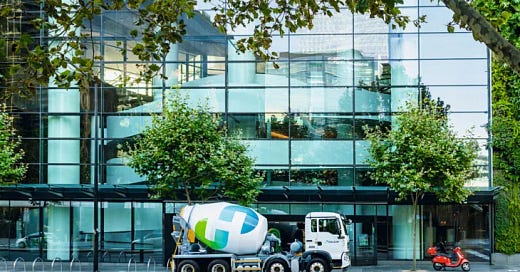💡DEEP DIVE - Holcim's big split
A Swiss industrial champion grabs headlines - in the United States
Dear Insider,
Swiss businesses (even the biggest ones) often go unnoticed on the world stage.
But sometimes - they grab the spotlight. 🔥
That was the case this week with the announcement that Holcim Group - the world’s largest cement producer - has decided to spin off its US-based business in an IPO listing in New York.
This has serious implications and multiple interesting angles.
Let’s dive in. 💡
💡Who is Holcim Group?
First, a look at the company itself:
Headquartered in Zug, Switzerland, Holcim Limited is the world's largest cement and building materials company, with a presence in over 70 countries.
Established in 1912 as Aargauische Portlandcementfabrik Holderbank-Wildegg in Switzerland, Holcim Group has evolved into a global leader in the construction industry, with a range of products, including cement, aggregates, ready-mix concrete, and other building solutions.
Holcim's global workforce of over 70,000 employees plays a crucial role in supporting infrastructure projects worldwide, from roads and bridges to housing and power plants.
In 2015, Holcim and Lafarge, two of the world's largest cement companies, announced their intention to merge in a deal valued at nearly $60 billion. The merger created LafargeHolcim, a company with a market capitalization of over $70 billion and a presence in over 90 countries.
💡Special note - Climate champion
Since its merger, LafargeHolcim has become a leading advocate for sustainability in the cement industry.
The company has committed to reducing its CO2 emissions by 25% by 2030 and to becoming carbon neutral by 2050.
It is also developing new technologies to produce low-carbon cement, such as carbon capture and storage (CCS).
💡Who is running Holcim?
These are the main names behind Holcim - and its growth and expansion/spinoff plans:
Jan Jenisch: Chairman of the Board of Directors and CEO of Holcim since 2017. Jenisch is a Swiss engineer with a strong track record in the construction industry. He has been instrumental in Holcim's transformation into a sustainable and circular leader - helping cut emissions at Holcim by 40% since 2020.
Martin Kriegner: Head of the Asia, Middle East, and Africa region (AMEA) for Holcim since 2023. Kriegner is a German executive with extensive experience in the global cement industry. He is leading Holcim's growth and expansion in the key AMEA region.
Toufic Tabbara: Head of the North American region for Holcim since 2023. Tabbara is a Lebanese-American executive with a successful track record in the construction industry. He is leading Holcim's operations and growth in North America and is planned to run the North American spinoff after its IPO.
Nollaig Forrest: Chief Sustainability Officer for Holcim since 2019. Forrest is a British sustainability expert with a deep understanding of the challenges and opportunities facing the construction industry. She is driving Holcim's sustainability strategy and leading the company's efforts to reduce its environmental impact.
💡A Swiss snub?
Holcim’s plans for a US IPO are not making everyone happy. On the one hand, the Swiss giant has grown to a size that it needs more capital and operational focus.
On the other hand - Swiss banks and the SIX Swiss Exchange are left empty-handed from one of the biggest deals of the year - if not the decade.
Wall Street giant Goldman Sachs has been tapped to advice Holcim on the listing (expected in 2025) and American boutique Perella Weinberg Partners is also acting as a financial advisor.
That means no role for UBS.
Meanwhile, SIX CEO Jos Dijsselhof downplayed the fact that Holcim will not list in Switzerland - but also admited in an interview with Bloomberg that the exchange needed to develop closer relationships with its members.
💡By the numbers
After the news of Holcim’s split broke, the company’s share price reacted positively.
More broadly speaking, Holcim has enjoyed steady share price growth over the past 5 years.
Zuercher Kantonalbank analyst Martin Huesler calculates that the US business’s fair value could be around $35 billion to $40 billion.
💡The Big Picture
Holcim’s decision to spin off its US business is no big surprise.
Although regrettable from a European perspective, the strategy of committing full attention to the US market with a separate US entity makes perfect sense.
A market as big as the US and with as much potential requires full focus and energy; Holcim is lucky that it grew big enough to have the problem of needing to split in order to sustain its growth.
Very likely many other European companies will follow in its footsteps.






